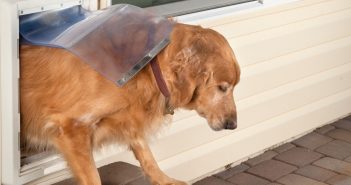Pets are highly valued family members. We love them tremendously, which is why it can be really difficult to see them undergo large amounts of stress. Unfortunately, cats and dogs experience anxiety just like people do, and it can often lead to behavior that can induce stress for you too.
Whether these behaviors involve barking, howling, peeing in the house, or tearing up furniture, they can be impossible to ignore, which is why it’s so important seek out solutions for treating and dealing with your pet’s anxiety. Fortunately, there are a few tips that can be really helpful in getting their stress under wraps — and getting both of your lives back on track.
Treating Separation Anxiety
One of the most common problems that dogs in particular suffer from is separation anxiety, which can cause them to exhibit distress and behavioral problems when they’re left home alone.
It’s estimated the between 20 and 40 percent of dogs suffer from separation anxiety. Although this was once believed to be caused by over-attachment to a human companion, it’s more of a phobia of being isolated. This can lead to irrational reactions from your dog when they realize you’re leaving the house, even if you’re often in and out.
Some symptoms of pet anxiety include:
- Aggressive behaviors, such as growling or biting
- Attempting to escape and run off to hide
- Overexertion from running and jumping during periods of high energy
- Excessive barking and howling without cause
- Excretion at random times
- Chewing and destroying furniture
- Changes in motor activity, such as trembling, a tucked tail, or reduced activity
If you notice that your pet’s separation anxiety is causing behavioral issues that are becoming a constant problem, such as regular peeing inside the house or on furniture, you may be desperate to get the situation under control.
It can be extremely frustrating to come home after a long day of work, only to realize you’ll need to take the time to get cat or dog pee out of your mattress before you can even lay down. If this is the case for you, it may be a good idea to see your vet or consult a behavioral therapist. If you feel that the situation hasn’t spiraled out of your control, giving your pets some extra training can help address these issues.
There are a few different ways to treat separation anxiety, and no single method works for all dogs. A few ways to treat separation anxiety in your pet include:
- Desensitizing your pet to leaving routines by associating leaving with positive feelings, such as by giving them treats before you leave.
- Leaving them for short intervals and slowly increasing the amount of time you’re gone so they can become more comfortable with your absence.
- Not making a big deal out of your arrivals and departures by ignoring them for a few moments when you arrive, only casually petting them after a few moments.
- Encouraging independence by training them to stay in a separate room from you while you’re both at home.
- Creating some distance between your pet by socializing them more with other dogs and dog owners.
- Leaving a piece of your clothing with your scent on it for them to lay with while you’re gone.
Getting Comfortable Around Other People and Dogs
If your pet exhibits signs of anxiety when they are around too many people or in a crowded area, it’s important to do what you can to help them be more comfortable in general. Of course, some dogs simply don’t like being around a lot of people, and this isn’t necessarily something you should aim to change.
If your pet is a rescue and experienced any kind of trauma or abandonment earlier in their life. However, if your pet’s anxiety around crowds seems minor and more like confusion, you can train them to feel more at ease by slowly increasing their exposure to these situations and being patient and reassuring with them.
If you recently adopted your pet and have noticed they become nervous when you take them around unfamiliar locations or people, it can be a good idea to dedicate some time to addressing these issues before you continue taking them out. A nervous dog can be a reactive dog, which can cause them to lash out if they feel unsafe.
This is especially important to remember in case your dog has interactions with children — who are not renowned at maintaining any semblance of personal space when it comes to petting dogs. Keep in mind that legal settlements for incidents involving dog attacks can be extremely costly, as dog bites can be more serious than they first seem. Consider the cost of training your dog as a small upfront investment to avoid big legal troubles down the road.
If it’s clear they don’t do well in these situations, start by letting others know that your dog cannot be pet. If you’re trying to socialize your pet, it’s best to avoid putting them under the additional stress of having strangers’ hands on them as you’re retraining them.
Instead, slowly begin taking them to areas with more people and dogs, and keep treats and toys on hand in case they begin to show signs of stress. Slowly increasing their exposure to situations around new people and dogs can help them get used to being in these conditions.
By allowing them to become familiar with these scenarios, they will stop reacting so strongly when around a new person or dog. This can be done by keeping your distance at a dog park so they can look but not interact with other dogs until they’ve proven that they won’t react poorly when they interact.
Knowing Their Limits
If your dog doesn’t respond to basic training, you may want to consult a dog behavioral specialist. It’s possible that your pet simply has limits that need to be respected, and if they don’t simply don’t like being pet or being around new dogs and people, that may just be their limit.
It’s important to recognize the boundaries your dog tries to set through their behavior and reactions. You can respect them by making them feel as comfortable as possible and giving them alone time when they need it.
Sometimes, there are underlying issues why your pet is unable to relax when you’re gone or around other people or pets. These underlying issues can often cause your pet to need treatment with anxiety medication, which can help address the mental issues that result in their anxiety. Some vets may even offer CBD oil to help treat pet anxiety, as this can help put them at ease. This natural substance has been proven to help treat anxiety, seizures and other conditions in dogs.
Dealing with an anxious pet can cause a lot of stress for a pet owner, as you often want to help them be as happy as possible under your care. However, by listening to their behavior, respecting their boundaries, and getting them the extra training they need, there’s a good chance you can help them out. As long as you care about them and are doing your best to give them what they need, that’s all your pet can really ask for.
Innovet started making health care products for pets in 2005! From CBD calming treats to assistance aids for blind dogs, they offer a variety of products carefully crafted by professionals who want nothing more than to see your pets get the help they deserve.
With Dave’s background in BioChemistry and Matt’s in Engineering, they made the perfect duo for product development and were able to come up with effective formulas for many issues. Driven by a passion for animals and aided by their technical knowledge, they became the largest pet CBD manufacturer across the world, yet they’ve remained focused on maintaining their humble beginnings. Learn more about their story here and check out their handy dosage calculator.




